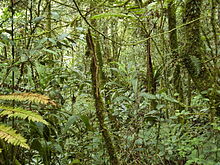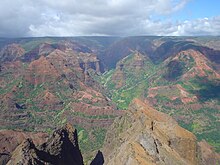Mountain forest
Mountain forest are generally all forests in mountain areas which are sold as far as the tree line extends.
In terms of vegetation ecology , however, only those forests are designated as mountain forests whose forest appearance differs extra-zonally from the typical vegetation of the climatic zone in which the mountains are located due to the mountain climate (and other location conditions caused by it ) . These are the forests of the montane altitude range (and in part) including the woody vegetation of the subalpine altitude range up to the tree line .
The climatic conditions and a mostly exposed location with strong sunlight make themselves felt in the growth form of the trees and in the low rate of growth. In Europe, the mountain forests are exposed to a lot of snow in long winters . In mountain forests, there are tree species that are adapted to nutrient-poor soils , strong weather fluctuations and sometimes strong relief energy .
Mountain forests (English Mountain Forests , or on the African continent also Scarp Forests ) occur on all continents except for the unforested Antarctica . The height above sea level at which the plant formations of the lowland forests change from the planar and colline levels to the montane levels varies worldwide.
The biological diversity of mountain forests (especially humid mountains) and the abundance of endemic species (both plants and animals) is usually very large in relation to the area due to the short distances between the different climates, so that about all five megadiversity centers on earth are tropical Mountain forests are.
Mountain forest is often also a protective forest for the villages and traffic routes in the valley , in these cases it is not felled for economic use and is declared a forest .
Alps
In the mixed mountain forest of the Alps are the beech , and at higher altitudes than mountain needle forest the Norway spruce , the European larch and pine TYPES forming stands, in the southern parts and oaks TYPES and sweet chestnut . Added to this are white fir , Swiss stone pine , sycamore maple , linden species , common ash , rowan , real whitebeam and green alder .
After the end of the last ice age around 7000 years ago, two thirds of the Alps were forested. Through clearing for the creation of settlement areas and through the use of trees, this proportion has now fallen to around a third. And these forest areas are also largely influenced by human use. This means that the forest there is used and maintained for forestry . The only larger remnant of a primeval forest in the Alps is the Rothwald in the Dürrenstein wilderness area in Lower Austria. In addition, the Scatle Forest in Graubünden and Derborence in Valais, possibly also the Bödmeren Forest in Canton Schwyz, are small remains (approx. 9–40 hectares). The forests of the Swiss National Park are z. B. emerged from reforestation after major clear cuts for the Hall salt works in Tyrol.
The wood of the alpine forests has been used intensively since the Middle Ages . In Genoa and Venice the ships of the fleets were built with it. As mining timber large quantities in the mining used. Many craftsmen also made their tools out of wood. In addition, there was the need for building houses and furnishing. However, the importance of the forest as a protective and ban forest was soon recognized. For example, the forest above the Swiss community of Andermatt was listed under protection as early as 1397 . Due to the use of various other materials besides wood, wood consumption has decreased significantly in the 20th century. So today there are again many areas where the wood growth is greater than the wood removal (e.g. in Styria ).
The Bavarian Alps

The Bavarian Alpine region is forested, with around 250,000 hectares of mountain forest almost half. Of these, 147,000 hectares are protective forest under the Forest Act for Bavaria (BayWaldG).
Overseas
New world
Mountain forests are found in South America's Andes as well as in North America, especially Canada. In the Sierra Nevada ( California ) there are dense mountain forests with coastal pine ( Pinus contorta , English Lodgepole Pine) and magnificent fir (English Red Fir ), until areas with whitebark pine spread in the subalpine zone .
A number of endemic species live in mountain forests in South America. The eastern slopes of the Andes from Cochabamba in Bolivia to Salta , Jujuy and Tucumán in Argentina are where the mountain forest screech owl is found . The owl occurs exclusively in mountain forests from 1000 to 2800 meters above sea level . Mountain forest screech owls, which inhabit higher altitudes, probably move to lower altitudes in winter.
Africa
The largest contiguous mountain forests can still be found in the middle of the continent. Angola has large forest areas in southern Africa. Here come u. a. the tree species White Stinkwood ( Celtis africana ), Forest Bushwillow ( Combretum krausii ) and Umzimbeet ( Millettia grandis ). The Natal Cycad ( Encephalartos natalensis ) occurs on stony ground in South Africa.
Asia

In Asia there are forested areas at all higher elevations. In Central Asia there are mostly isolated arid forest areas (Mongolian Govi and in the Altay Mountains ). Large areas of mostly tropical mountain forests can also be found on the islands of Southeast Asia.
See also
Individual evidence
- ^ Richard Pott: General Geobotany. Biogeosystems and Biodiversity. Springer, Berlin, Heidelberg, New York 2005, ISBN 3-540-23058-0 . Pp. 281, 356.
- ↑ Under pressure: mountain forest and mountain agriculture. Retrieved October 29, 2019 .
- ↑ a b Sabine Joss: In the mountains . Haupt Verlag, Bern, Stuttgart, Vienna 2012, ISBN 978-3-258-07674-4 , pp. 129-137 .
- ↑ Wilhelm Barthlott et al .: Geographical patterns of vascular plant diversity on a continental and global scale. Published in Erdkunde Vol. 61, no. 4 (October to December 2007) pp. 305-315, table p. 308, online version .
- ^ Bavarian State Ministry for Food, Agriculture and Forests (StMELF) . Retrieved December 22, 2015.
- ↑ Bavarian State Ministry for Food, Agriculture and Forests (StMELF; Ed.): The protection forest in the Bavarian Alps , 2002.
- ↑ Claus König et al., P. 295


